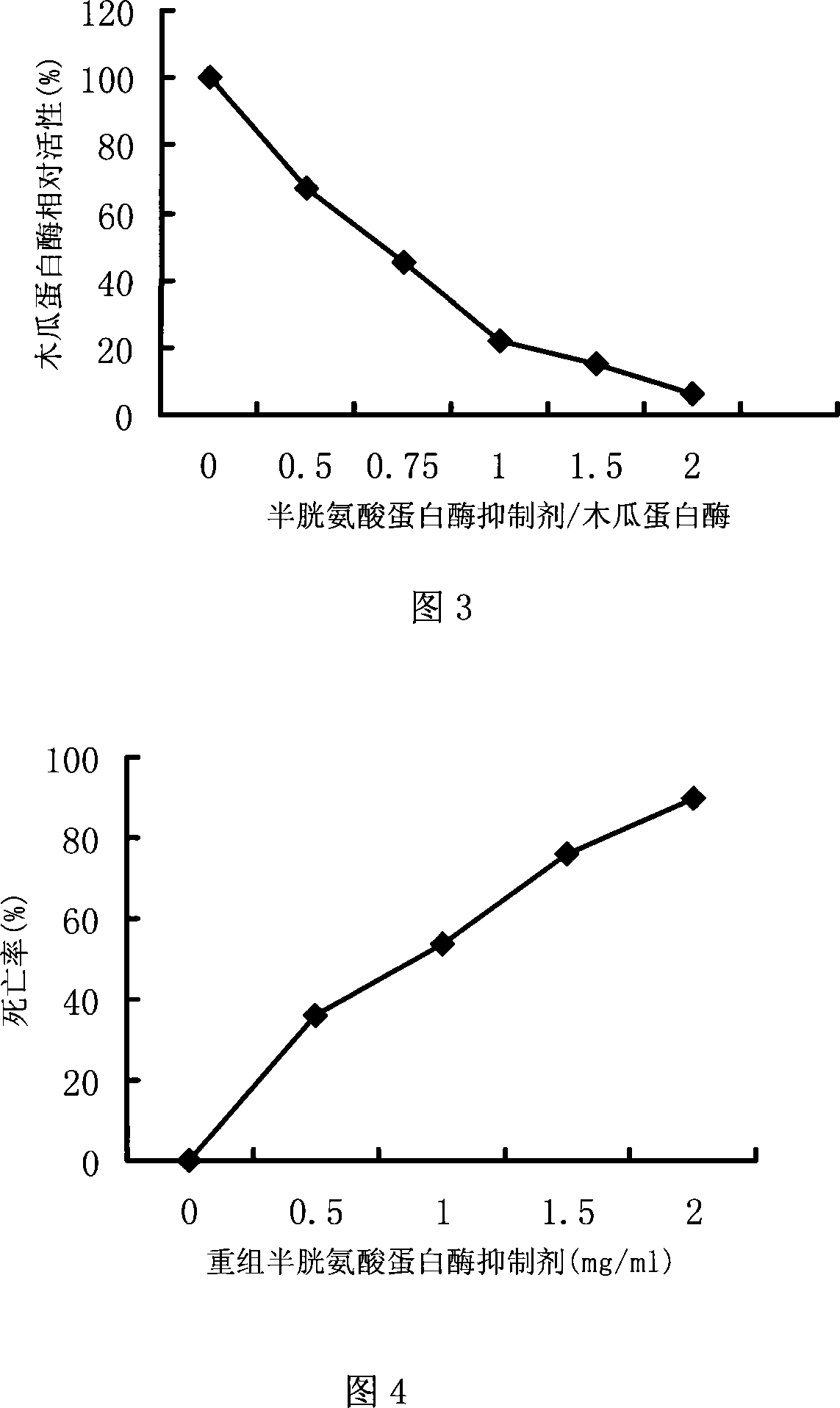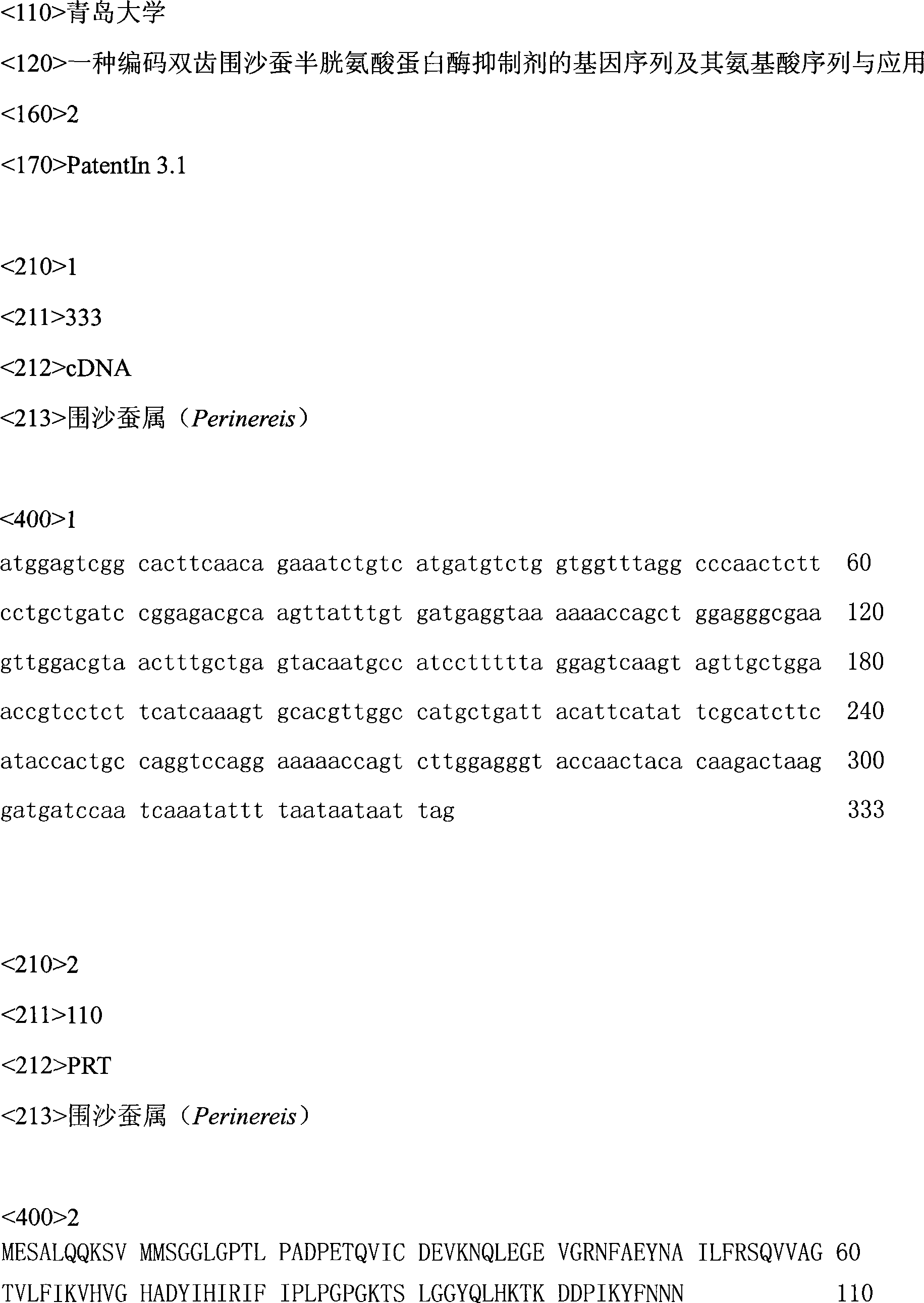Gene sequence of coding perinereis albuhitensis grube cysteine protease inhibitor and its amino acid sequence and application
The technology of cysteine protease and the double-toothed nematode is applied in the field of agricultural biology, which can solve the problem that there is no coding gene of nereid cysteine protease inhibitor, and achieve the effect of preventing and controlling agricultural insect pests.
- Summary
- Abstract
- Description
- Claims
- Application Information
AI Technical Summary
Problems solved by technology
Method used
Image
Examples
Embodiment 1
[0025] Example 1: Construction of the cDNA library of P. didentate worm and cloning of genes encoding cysteine protease inhibitors
[0026] 1. Using 2 g of Nereis cerevisiae didentate live tissue as material, total RNA was extracted using RNAiso Reagent (TaKaRa Code No.D312).
[0027] 2. Use Oligotex-dT30 mRNA Purification Kit (TaKaRa Code No.9086) to extract mRNA.
[0028] 3. Using 5 μg mRNA as a template, use the TaKaRa cDNA library construction kit to construct a cDNA library, specifically including the following steps:
[0029] (1) Use reverse transcriptase M-MLV and Oligo (dT) anchor primer to synthesize the first strand of cDNA, using 5-methyl dCTP during synthesis;
[0030] (2) Utilize RNaseH, Escherichia coli DNA polymerase and DNA ligase to synthesize the second strand of cDNA;
[0031] (3) smoothing the ends of the double-stranded cDNA using T4 DNA polymerase;
[0032] (4) Ligate with the linker containing the NotI recognition sequence, and then digest with NotI...
Embodiment 2
[0047] Example 2: Expression of cystatin gene in Escherichia coli and purification of expression product
[0048] 1. According to the obtained cDNA sequence, design a pair of primers,
[0049] Primer 1: 5'ACATGACTACATATGGAGTCGGCAC 3'; Primer 2: 5'ACCCTCGAGCTAATTATTATTA 3'Using the cDNA of C. bidentata protease as a template, the cysteine protease inhibitor gene was amplified using Taq DNA polymerase, and the amplification condition: 94 Denaturation at °C for 45 sec, annealing at 50°C for 45 sec, extension at 72°C for 45 sec. A 330bp fragment was obtained (in FIG. 1: 1. pET-15bI / XbaI, XhoI; 2. λDNA / EcoRI, HindIII).
[0050] 2. After cutting with NdeI and XhoI, clone it into the expression vector pET-15b to construct the expression vector pET-15bI, transform the expression vector into E.coliBL21(DE3), and construct the engineering bacteria.
[0051] 3. Pick a single colony of engineering bacteria, inoculate it in 20ml of LB medium containing 100μg / ml ampicillin, culture it w...
Embodiment 3
[0056] Example 3: Inhibition of papain by recombinant cysteine protease inhibitors
[0057] Mix papain with recombinant proteins in different molar ratios in a buffer solution, and measure the activity of papain after incubation at 25°C for 15 min. The buffer solution used is Tris-Cl buffer solution (50mM, pH7.0, 2mM dithiothreitol , 50mMNaCl). Add 50 μl untreated or recombinant protein-treated papain (0.1 mg / ml) and 100 μl L- BAPNA (the chromogenic substrate of cysteine protease, 2.0mg / ml), add 350μl of 10% hydrochloric acid solution after incubation at 37°C for 10min to terminate the reaction, measure the absorbance value at 405nm wavelength to determine the relative activity of papain. Taking the relative activity (%) of papain as ordinate, the mol ratio of recombinant protein and papain is drawing on abscissa, the result is as shown in Figure 3, along with the increase of recombinant protein mol ratio, the activity of papain reduces gradually, when When the molar rat...
PUM
| Property | Measurement | Unit |
|---|---|---|
| Molecular weight | aaaaa | aaaaa |
Abstract
Description
Claims
Application Information
 Login to View More
Login to View More - R&D
- Intellectual Property
- Life Sciences
- Materials
- Tech Scout
- Unparalleled Data Quality
- Higher Quality Content
- 60% Fewer Hallucinations
Browse by: Latest US Patents, China's latest patents, Technical Efficacy Thesaurus, Application Domain, Technology Topic, Popular Technical Reports.
© 2025 PatSnap. All rights reserved.Legal|Privacy policy|Modern Slavery Act Transparency Statement|Sitemap|About US| Contact US: help@patsnap.com



